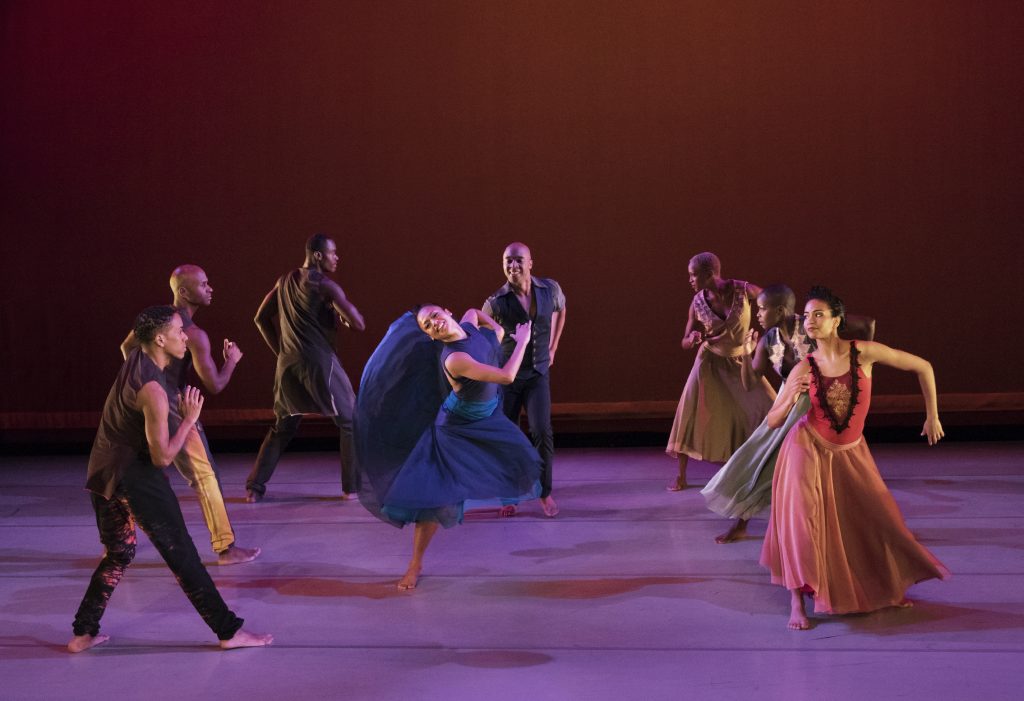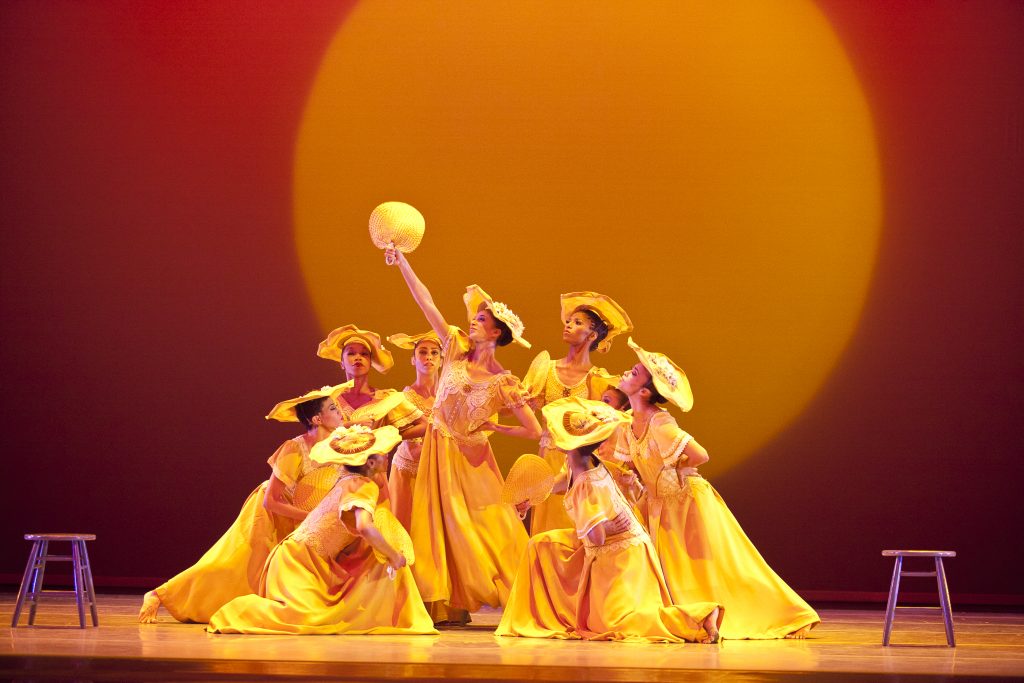
This time around, it was the past that was the highlight of the program when Alvin Ailey American Dance Theatre came back into town Feb. 28 to perform again at the Kravis Center for the Performing Arts.
Revelations, choreographed by founder Alvin Ailey almost 60 years ago and the undisputed cornerstone of the company’s repertory, was the backbone of the evening. Though the troupe presented three recent works, the program iot presented was not as boldly etched as the one it delivered three years ago.
Open Door, choreographed in 2015 by Ronald K. Brown, began the evening’s performance. The-10 member cast seemed to really enjoy dancing to the blend of Afro-Latin jazz and we, in turn, enjoyed watching them.
Jacqueline Green — dressed in a fabulous dark blue dress with peeking green under-layers — introduced the vocabulary. Moving deliberately through the sequence of steps, she sculpted a striking solo that had an almost academic nature to it. She was replaced by Yannick Lebrun, who went through the same movements and made his own interpretation of the steps. Then they came together and repeated the movements in a side-by-side duet.
The very attractive costumes by Keiko Voltaire and the extraordinarily color-saturated lighting by Al Crawford greatly added to the work, creating a vibrancy that the choreography started to lose as the dancers entered and exited with only minor variations of the same steps. Towards the end of the dance — despite the catchy rhythms of Luis Demetrio, Arturo O’Farrill and Tito Puente — it started to feel like the club scene and an evening that had gone on for too long.
Though there were some well-danced solos and duets sprinkled through the work, there was little development in the actual choreography. The dancers kept repeating their set vocabulary of movement with some simple changes of structural order while dancing mostly side-by-side in groups with no actual partnering. By the end, it was more than enough.
The After The Rain Pas De Deux (2005) is an excerpt from a longer work by ballet choreographer Christopher Wheeldon. It had a very different look on the two Ailey dancers than it did when it was set on New York City Ballet in 2005. Originally set on pointe for the lithe ballerina Wendy Whelan and her partner Jack Soto, the numerous spectacular lifts seemed weightless with Whelan just seeming to float up into the air.
Here, because of the equally strong and sculpted muscularity of the two Ailey dancers, it had a more acrobatic look. The highly defined bare legs of Jacquelin Harris were visually balanced by Michael Jackson Jr.’s chiseled bare chest. Their partnering was amazing but it had a more physical and intentioned quality to it.
Set to the familiar Spiegel im Spiegel (a spare melody for violin and piano by Estonian composer Arvo Pärt), the pas de deux was a welcome contrast to the two group works — Open Door and Exodus — which featured primarily side-by-side dancing with no partnering at all.

Next up was Exodus, created in 2015 by Rennie Harris, the hip-hop artist who broke into the concert dance world as a choreographer and has set numerous works on both ballet and modern dance companies. His company, Rennie Harris Puremovement, performed at the Rinker Theatre four years ago.
What really struck me as I watched Exodus was how the Ailey dancers were so able to move not just from one type of dance to another but particularly from ballet to hip-hop. They are polar opposites in dance but the Ailey dancers really pulled out all the moves and they looked terrific dancing hip-hop.
Exodus, effectively lit by using strong white sidelights, began slowly and soberly, revealing a dark stage strewn with bodies. In that harsh light, the striking Jeroboam Bozeman stood tall among the fallen figures. In the void, a voice recited some poetic prose, a gunshot was heard and a woman cradled the struck man as she grieved. Bozeman consoled her and with a mystical hand gesture revived the man.
Dressed in everyday street clothes and sneakers, the dancers reached with one arm up in a gesture of desperation as others shook and trembled. After another gunshot, they started to exit and reappear dressed in the same stylized white clothes and sneakers as their leader Bozeman. The simple change of costume gave the work a feeling of a transformation or a journey towards some kind of enlightenment.

Throughout the work, the dancers displayed total ease with the speed, isolations and intricacies required in hip-hop. The distinctive moves, which were danced mostly together and side-by-side, continued to be fascinating as long as I focused on one particular dancer at a time. Each performer was quite amazing. But when viewed collectively, the ensemble movement — with its casual approach to unison work — started to lose its appeal as there was little choreographic development used to craft the movement.
It was nice to see the Ailey performance at the Kravis so well-attended. 0A much younger-than-usual audience filled the balconies and showed great appreciation for the company and especially for Revelations, the enduring work by founder Alvin Ailey, that traditionally closes the program.
Choreographed nearly 60 years ago, Revelations seemed more realized and therefore more satisfying as a concert dance work. The two other group works seemed to be more about the body moving and not so much about the craft of assembling the movement on groups of dancers and creating choreographic structure. Both were enjoyable but not particularly memorable. But Revelations? It’s one of those legendary dance works that has a sense of completeness that sticks in your imagination forever.
In 10 vignettes, Ailey masterfully captured the essence of the spiritualism and hope that played such an important role in African-American history. Inspired by his childhood memories in rural, segregated Texas, he gloriously depicted images of the joys, sorrows and struggles that beset his community during the Depression.
The beauty and poignancy of the opening, with its tight formation of dancers moving to “I Been ’Buked,” is still just as wonderful as I remember it. Equally special was the performance of “Fix Me, Jesus.” In this duet, simplicity spoke so effectively. Sarah Daley and Yannick Lebrun were the wife and husband needing to learn to trust each other. The ending tableau had Daley balancing high on Lebrun’s thigh in a beautiful but precarious arabesque.
And of course, there was the rousing, sing and clap-along finale of “Rock My Soul in the Bosom of Abraham” that sent the audience home in high spirits.
Revelations is undoubtedly one of the most seen (and enjoyed) modern dance works in the world. Seeing it again on Tuesday night was like slowly flipping the pages of a gorgeous color photography book — lingering and savoring each moment before you turn the page to the next anticipated image.